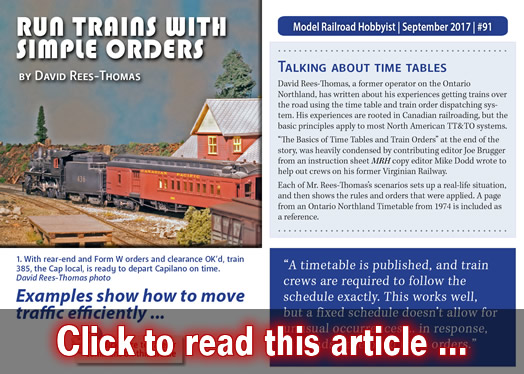Operations

Inspiration fosters a plan – using a conductor in operation
I was recently inspired by a video that Tom Klimoski posted on his YouTube channel showing operation on his Georgia Northeastern RR. In the video, Tom had a conductor figure placed where appropriate for the train moves.
My small branch line is still far from full operations, but Tom’s video got me excited about the possibility of incorporating an actual conductor into my eventual operation. How could I use a figure in a way that was realistic yet not cumbersome for my operators? I decided I would figure out a way to make it work.

Railroads Hauling of Rock Salt
I have spent some time planning a switching layout based on the Troy NY industrial layout that was in RMC a couple of years ago. CSX and CP switch three customers, a feed mill, a logistics warehouse in the old NYC freighthouse and stored road salt. I want to back date to about 1984 and substitute DH and Conrail locomotives, already acquired. I think currently a lot of salt comes off the Genessee and Wyoming in 2 bay ACF cars. But I don't know where the salt came from and how it was hauled back in 1984. Would old PS 2 bay hoppers be a good guess?

When things are that old, there is no fixing them...
Over the past three weeks I having busy programming the logic for the layouts signal system into JMRI - Panel Pro and testing it out on the already installed signals on the layout.

Pigeon Point
At the south end of the Delaware River Extension in Wilmington is the car float apron at Pigeon Point. The P&R/RDG floated cars across the Delaware River to chemical plants in Carney's Point and Thompson's Point in New Jersey. To simulate this I have a fold down shelf to hold the car float when it is docked. I have been putting this off for some time trying to figure out how to build it. Finally came up with a plan. The float was made from .040 plastic sheet and will hold six 36 ft cars or eight 30 ft cars. Construction of the float apron and

Freight Car Routing Project finished
I have now submitted my final project report for my TM470 Router Open University project. 11,000 words in the report body and 22,000 overall including the JavaScript code and my project blog.

First Full Ops Session
When you're just keeping your head above water on a major layout project, you may not realize that you've reached a major milestone until you're right on top of it. And if you're not careful, you may just blow right past it. That almost happened during my last ops session on the Valley Line. Read more about it in the lastest post at http://www.thevalleylocal.net Enjoy!
Chris
Modeling the New Haven Railroad's Connecticut Valley Line in October, 1948

RR's and Hurricanes
Since we have an impending hurricane, I thought it might be interesting to tell the MRH readers what real railrods are doing because of the hurricane.
The railroads have been watching the storm since it entered the Gulf. Once it strengthed to where it looked like a hazard (about two or three days ago, they would begin making plans.
Every ballast car in the region (maybe the system) would be loaded and sent to staging areas about 100-200 miles inland. Carloads of ties (for cribbing) and bridge material would also be inventoried and possible pre-positioned.
Hybrid Car Card/Waybill & Computerized Car Forwarding
Those of you interested in computer-assisted car forwarding systems may have read some of the posts that I've submitted during the summer about the Shipper-driven Traffic Simulator, a free, web-based, multi-user system that generates freight traffic and can also track cars, print waybills, switchlists, etc...
>> Posts index
Navigation
Journals/Blogs
Recent Blog posts:
